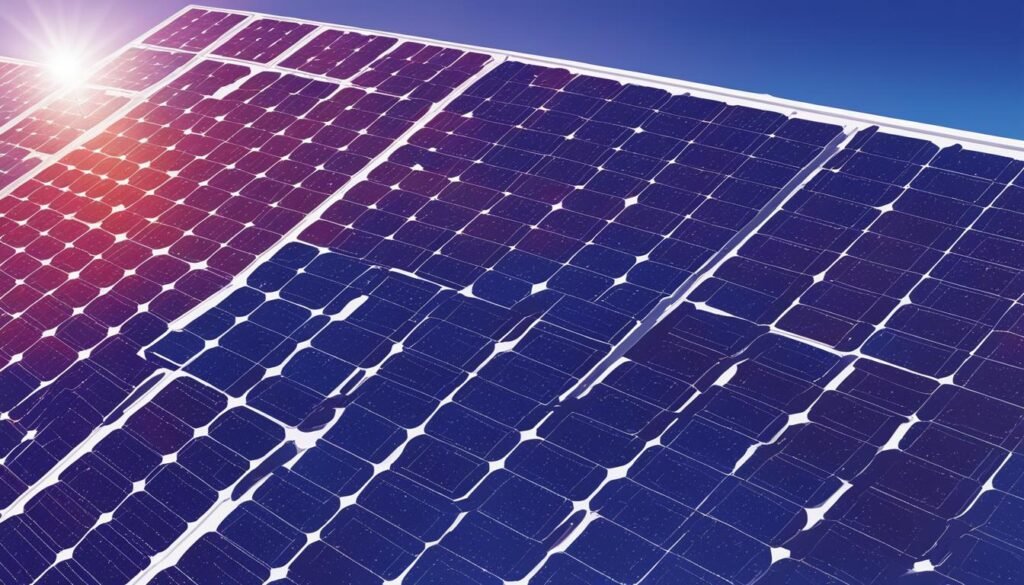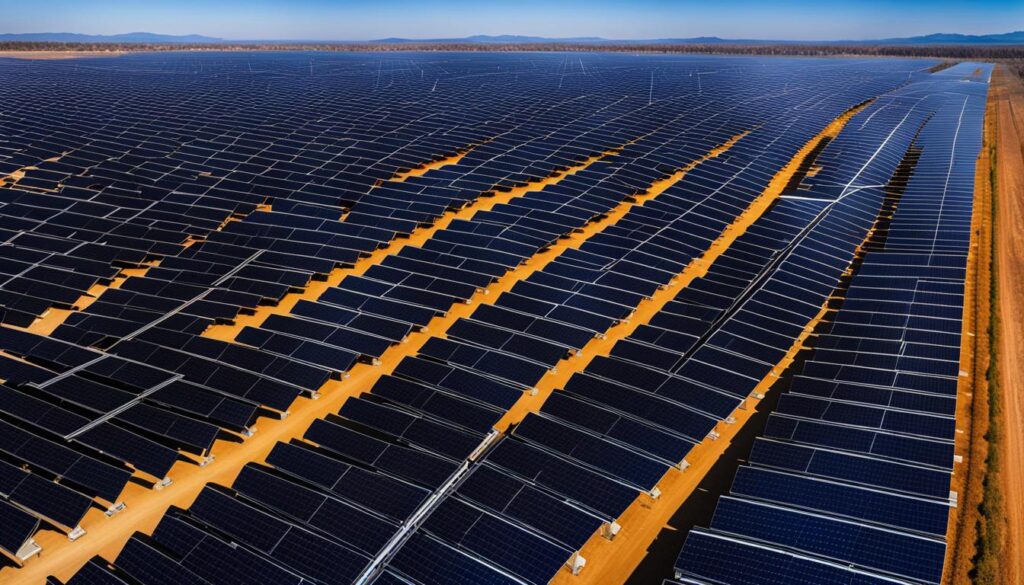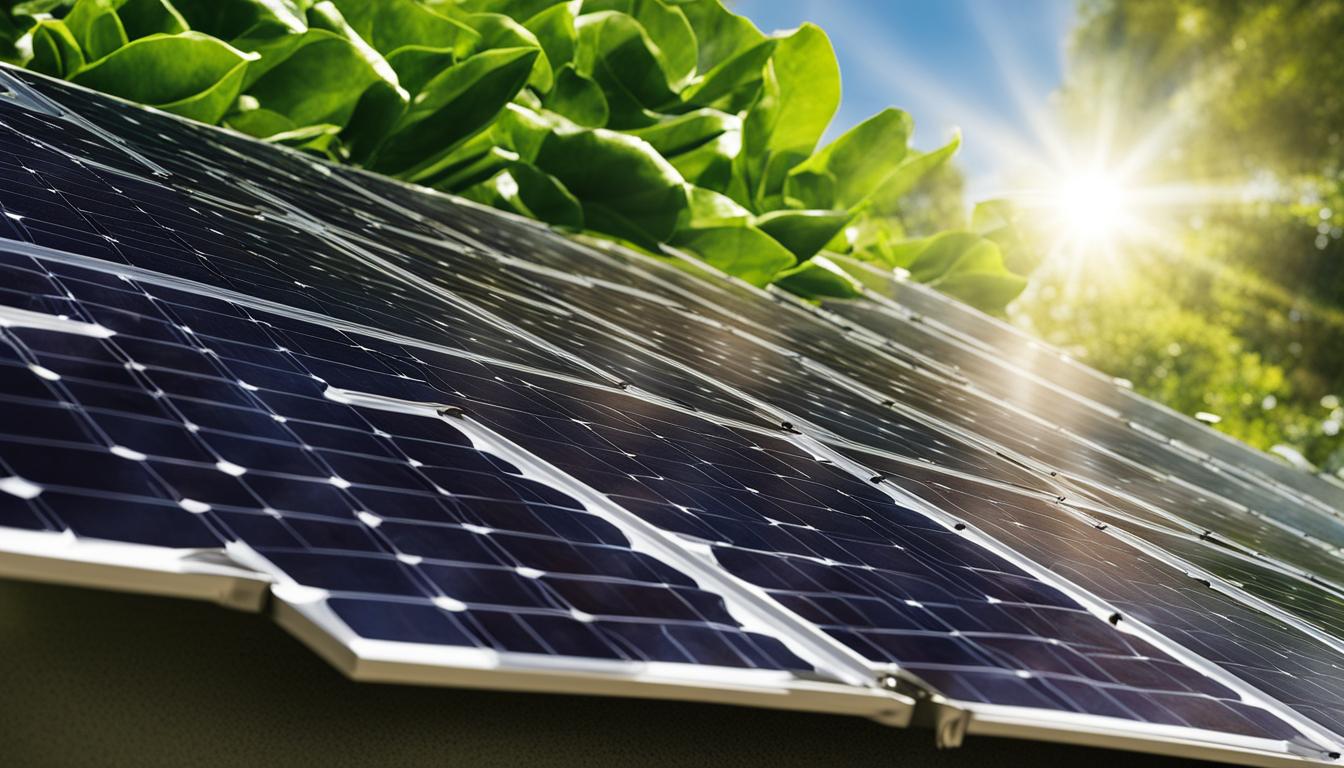Let me shed some light on a bright topic – solar panel wattage. Everyone’s talking about harvesting the sun’s rays, but I’m here to plug into the specifics: just how many watts are these shiny photovoltaic beauties pumping out? The crux of solar panel power output isn’t just a number plastered on the back of the panel; oh no, it’s a testament to human ingenuity and the relentless pursuit of energy production that’s as green as freshly mowed grass.
For those out there pondering how much juice their future solar setup could squeeze out, the nitty-gritty lies in understanding the solar panel electricity generation process under certain test conditions. Imagine an artificial sun precisely measured at a 1,000 watts per square meter love tap. These panels get cozy at an ideal 25°C, sunbathing at the perfect 48.19° angle. This is the stage where solar panel energy production struts its stuff, whispering those efficiency ratings into the ears of brands like SunPower and Canadian Solar, who, by the way, could win a wattage marathon with up to a hefty 22.8% efficiency.
But let’s not fall for the illusion that all solar panels are created equal. In the world where the rubber meets the roof, the power output might just dial back, sort of like how I feel on Monday mornings. It’s not just about the panel’s potential; it’s also about how well it plays with others – the inverters, the batteries, and the unpredictable elements that throw shade, literally and figuratively, on our solar dreams.
Key Takeaways
- Solar panel wattage is the superhero identity of a panel’s potential power.
- Standard Test Conditions are the avatars of an ideal photovoltaic world.
- Efficiency ratings are more than just figures; they’re badges of honor for the likes of SunPower and Canadian Solar.
- The actual solar panel power output can be as unpredictable as weekend plans.
- Other system components join the solar panel electricity generation squad to maximize effectiveness.
- Installation is the secret sauce; without it, you’re just a wannabe in the world of wattage.
- Embrace the reality of solar potential, but don’t get blinded by the sunlight. Always wear your shades.
Understanding Solar Panel Efficiency and Performance
I’ve always been fascinated by the promise of solar energy. It’s like magic, harnessing the sun’s power to fuel our homes and lives. But it’s not all abracadabra and fairy dust. The nitty-gritty of solar panel performance and solar panel efficiency lies in the science of converting sunlight into electricity. When I delve into calculating solar panel wattage, I put on my wizard’s hat and look to the standard test conditions to reveal the secrets of solar alchemy.
Solar Panel Wattage Under Standard Test Conditions
Standard Test Conditions, or STC – it sounds more like a tropical disease than a benchmark for solar panels, doesn’t it? But these STC are the lab conditions under which a solar panel’s power capacity is measured. Picture this: a controlled environment blasting 1,000 watts per square meter at your solar panels, with a comfy cell temperature of 25°C. That’s where you get your wattage rating from, folks. And that’s the number that I use when I’m busting out my calculator to figure out just how much wattage we’re talking about.
What Solar Panel Efficiency Ratings Tell Us
Now, if solar panel efficiency were a personality trait, it would be the charm – it tells us how appealing a panel is. Picture efficiency as a percentage figure; let’s say, a dashing 22%. That means for every square meter, the panels are popping out 220 watts of power. It’s a bit like judging a book by its cover, but this cover comes with numbers that prove it’s more than just looks – it’s substantial.
Comparing Solar Panel Brands: Who Leads the Efficiency Race?
Finally, the showdown between solar panel brands is akin to a race where everyone’s dying to wear the yellow jersey. It’s not the Tour de France, mind you, but it’s just as competitive. We’ve got big names like SunPower and Canadian Solar flexing their muscles with efficiencies north of 22.8%. That’s the kind of stat that gets me out of bed in the morning – clean, green energy that’s outperforming yesterday’s benchmarks!
| Brand | Efficiency | Module Type | Performance under High Temperature |
|---|---|---|---|
| SunPower | 22.8% | Monocrystalline | Excellent |
| Canadian Solar | 22.8% | Monocrystalline | Very Good |
| Others | 18%-22% | Mixed | Good to Average |
There you have it, solar enthusiasts and sun worshippers. By understanding the watts, the efficiencies, and the brand battles, you can choose a solar panel that sings in harmony with your environmental spirit and your love for cutting-edge tech.
Real-World Factors Influencing Solar Panel Power Output
When it comes to calculating solar panel wattage, I’ve learned that what you see is not always what you get. The scenario is akin to the calorie count on your favorite frozen pizza – sure, it says 300 calories per slice, but only if baked to perfection. Similarly, a solar panel’s wattage rating under the ideal laboratory of Standard Test Conditions (STC) may tantalize with its promise. Yet, bask those same panels under the actual sun, with all its moody weather and the not-always-predictable Earthly variables, and your solar panel power generation numbers might need recalibration.
So why this discrepancy, you ask? Let me paint you a picture of reality versus the laboratory – a place often more akin to a sauna or icebox than the moderate 25°C used during tests. In fact, for those panels soaking up rays in sizzling hot climates, their power output is likely shrinking by about -0.3% to -0.5% for every degree above that comfortable 25°C threshold. That’s right; a panel strutting around with confidence in its 300W nameplate might actually be struggling to cross the 270W mark on a blistering summer day.

Moreover, let me introduce you to components you’d certainly not invite to your efficiency party – inverters and batteries. These essential sidekicks in converting your panel’s DC achievements to your home’s AC needs and storing energy for a rainy day sadly don’t operate at full tilt, sapping a bit more off the top of your generation hopes.
| Component | Function | Typical Efficiency |
|---|---|---|
| Inverter | Converts DC to AC | 95-98% |
| Battery | Stores excess power | 90-95% |
So let’s not be blinded by the lab’s lustre. Instead, by understanding these real-world factors, we get to gauge and appreciate the tenacity of these solar powerhouses as they turn each precious ray into usable energy, against all odds. And frankly, that’s a tale of resilience I am here for, much like cheering on the underdog in an epic sports showdown. Calculation complete?
Calculating Solar Panel Wattage for Your Home
Alright folks, let’s play with some numbers to figure out your home’s solar potential. We’re talking solar panel watt capacity and solar panel power output, the dynamic duo of the solar world. The secret sauce? A nifty little thing I like to call the Global Solar Atlas. It’s cooler than your friend’s retro sunglasses and just as useful.
Now, before we dive into the deep end, let’s remember the lifeguard’s advice: always check the local weather report—or in our case, the expected sun hours. It’s like knowing how much wind is behind your sail; it powers the whole shebang.
Once you’ve got your locale’s sunny forecast, it’s just a hop, skip, and a jump to calculate your system’s annual output. Picture this scenario: you’ve got a shiny 8kW solar system with 20 panels chilling on your roof. They’ve got a cushy job, soaking up rays to churn out an estimated 12,000 kWh every year. Break out the calculator, and you’ll see each panel is your very own 600 kWh generator.
If you ask me, it’s a beautiful thing. Not just because of those lower electricity bills, but because it feels like you’ve got a bit of the sun’s power in your pocket. So go ahead, take this info for a spin, and see if your house is ready to join the renewable revolution. Because when it comes to solar, knowing your numbers is as satisfying as a perfect piece of toast. Browned just right, no burnt edges—solar perfection.
How Many Watts Does a Solar Panel Generate
Ever wondered just how much juice you could squeeze out from an array of sleek solar panels adorning your rooftop? Let’s illuminate the subject and break down the numbers. We’ll explore the direct correlation between solar panel wattage and the scintillating dance of photons that grace our homes with electricity.

Daily Energy Production Capabilities
Consider this: your standard home runs the gamut from 250 W to 400 W solar panels. If we hitched a ride on a sunbeam, we could see these energy maestros belt out around 1.5 kWh of power each day. Although, like a live performance, the output does vary day to day. A bevy of factors such as tech efficiency and a stage called local peak sunlight hours sway the tune. By harnessing tools akin to the Global Solar Atlas, I can predict the daily energy production capabilities like a modern-day oracle.
Annual Energy Production Estimates
Oh, and you’re in for an annual encore. A modest incarnation of a 1 kW solar panel setup serenades you with approximately 850 kWh yearly. We aren’t just talking capacity here; it’s a sophisticated symphony of efficiency, materials, roof angling (no, not your dance moves), all playing to the geographical locale of the setup. Painting with a broader stroke, panels in England’s sunny southern serenade are more productive compared to their northern kin, spotlighting how location can choreograph the productivity of our solar panels with annual energy production estimates that set the stage for sustainability.
The Impact of Solar Panel Type on Power Output
When it comes to upping the ante in our solar panel energy production game, not all heroes wear capes—some come in the form of silicon cells. Yes, I’m talking about the dynamic trio: monocrystalline, polycrystalline, and thin-film panels. Each type wields its unique powers in the battle against inefficiency and space constraints. Let’s dive into what makes these solar protagonists tick and how their special powers can light up your home, literally and figuratively.
https://www.youtube.com/watch?v=jncFKHZt7GM
Monocrystalline vs Polycrystalline vs Thin-Film
Imagine each solar panel type as a character straight out of a superhero flick. Monocrystalline—the veteran—brings to the table a high-power output ranging from a robust 320 W to an impressive 380 W. On the flip side, polycrystalline, the reliable sidekick, boasts a respectable range of 250 W to 300 W. Then we have thin-film, the underdog, whose efficiency may not be as high, but its flexibility and ease of installation lend a hand in specific scenarios where traditional panels just won’t fit.
Understanding the Power Range of Different Solar Panels
Behold a table that will make your choice between solar panel types as clear as a sunny day. It’s like walking into a solar buffet and seeing exactly what each type puts on your energy plate:
| Type of Solar Panel | Power Output Range (Watts) | Efficiency Level |
|---|---|---|
| Monocrystalline | 320 – 380 | High |
| Polycrystalline | 250 – 300 | Medium |
| Thin-Film | Less than 200 | Low |
Decisions, decisions! The roof space you’re working with might just favor one type over another. And if you’re stuck in a pickle, remember that while monocrystalline might give you the best watt for your buck, don’t discount thin-film’s ability to stick to surfaces the others can only dream of.
Strategies to Maximize Your Solar Panel Power Generation
As a solar panel enthusiast, I’m always on the hunt for cutting-edge ways to squeeze every watt out of my beloved photovoltaic friends. Let’s face it, installing solar panels is much like finding the perfect spot for that big-screen TV—location is everything! You want to catch those golden rays like your life depends on it. And, because it’s me we’re talking about, I make sure to follow a few savvy strategies to hit the jackpot in energy production.
Optimal Installation for Maximum Light Exposure
The solar panel tango starts with nailing that optimal solar panel installation. You might think you’ve got the best spot picked out, but are you sure there’s not a pesky tree or a towering chimney ready to throw shade—quite literally? To ensure maximum light exposure, you have to play chess with Mother Nature. It starts with a pristine, south-facing roof and ends with me doing a happy dance as I watch those panels soak up the sun.

Now, unless you’re a seasoned solar architect or just someone who likes to climb onto your roof for fun, you’ll want to bring in the pros. These folks have been to the rodeo before; they’ll angle those panels at the perfect tilt and steer clear of those shadowy offenders that can dent your power generation dreams.
Regular Maintenance and System Monitoring
But the quest for maximizing solar panel power generation doesn’t stop at installation. It’s a marathon, not a sprint, folks. I’ve learned that the key to maintaining those high numbers is a mix of Mr. Clean and tech-savvy vigilance. That’s right; those panels need a good bath now and then to keep them squeaky clean and banish any grime that could be blocking their mojo.
And who can forget about solar panel system monitoring? With a trusty app linked straight to my inverter, I’m like the James Bond of solar intelligence, keeping an eye out for any dips in performance or potential panel pandemonium. It’s how I ensure my system is working tirelessly to pump out every kilowatt hour it’s got. Call it my personal solar fitness tracker; we’re talking about hi-tech care for high-watt gains.
By sticking to these simple yet brilliant strategies, I rest easy knowing my solar array is flexing its muscles each day. With some expert help and diligent tending, I’ve managed to keep my power generation numbers dancing beautifully close to those sweet STC-rated wattages. And, if I may say so, my return on investment is looking sunnier by the day.
Solar Panel Power Generation: Myth vs. Reality
Let’s face it, when it comes to solar panel power generation, the lines between fact and fiction can be as blurred as a foggy morning in San Francisco. I’m here to clear the fog and shine a bright, unfiltered light on the real deal with solar energy so that you’re not left in the dark—figuratively speaking, of course.
Debunking Common Misconceptions About Solar Output
It’s been said that solar panels only work in sizzling summer heat and under the kind of clear skies that postcards are made of. Well, give me a break! What’s really cooking is this solar panel power generation myth. In the actual world, where you and I live and pay electricity bills, solar panels can still bring their A-game even as the temperature rises. Sure, those sun-soaked days are like a solar panel’s dream come true, but excessive warmth? Not so much! Too much heat can actually make solar panels less effective—consider this myth busted.
How Weather and Seasons Affect Solar Energy Production
Onwards to nature’s mood swings—yes, I’m talking about weather and seasons—and their effects on solar production. When autumn paints leaves in shades of gold, and winter wraps the world in a chilly embrace, solar panels face their own set of challenges. Shorter days and a sun playing hide and seek behind clouds mean that solar panels can indeed take a production hit. Yet, take heart, my sun-chasing friends, because high-efficiency panels today are designed to seize every possible ray, ensuring those cost savings on your energy bill remain a reality, season after season.
FAQ
How Much Wattage Does a Typical Solar Panel Produce?
A standard residential solar panel typically generates between 250 W and 400 W, but the actual amount of electricity produced can vary based on factors like efficiency and sunlight.
What Do Solar Panel Efficiency Ratings Indicate?
Solar panel efficiency ratings indicate the proportion of sunlight that can be converted into usable electricity. The higher the efficiency rating, the more power output per area of the solar panel.
Which Solar Panel Brands Are Known for High Efficiency?
Brands like SunPower and Canadian Solar are renowned for efficiency, with some models achieving up to 22.8% efficiency, placing them among the leaders in the industry.
How Do Real-World Conditions Affect Solar Panel Power Output?
Real-world conditions such as shading, dust, temperature, and the efficiency of system components like inverters can all impact the power output of solar panels, often resulting in lower performance compared to ideal Standard Test Conditions.
How Do I Calculate the Solar Panel Wattage Needed for My Home?
To estimate the solar panel watt capacity for your home, consider your energy usage, peak sunlight hours in your area, the efficiency of the solar panels you’re considering, and the size of the roof space available for installation.
What’s the Daily Energy Production Capability of a Solar Panel?
Depending on local peak sunlight hours, a 250 W to 400 W solar panel can generate roughly 1.5 kWh per day. This can vary based on factors like geographic location, time of year, and weather conditions.
How Can I Estimate the Annual Energy Production from My Solar Panels?
The annual energy production of a solar panel system can be roughly estimated by multiplying the peak capacity of your system by the expected average sun hours, adjusted for local conditions and panel efficiency.
Does the Type of Solar Panel Affect Its Power Output?
Yes, the type of solar panel affects its efficiency and power output. Monocrystalline panels are typically the most efficient, followed by polycrystalline, and then thin-film panels, which usually have the lowest efficiency and power output.
How Does Panel Size Influence Solar Panel Energy Production?
The size of the solar panel influences its energy production capabilities. Larger panels will generally have a higher wattage and thus greater energy production, assuming similar efficiency levels.
What Are Some Strategies to Maximize Solar Panel Power Generation?
Maximizing solar panel power generation includes ensuring optimal placement, avoiding shaded areas, conducting regular maintenance, and proper installation techniques. Monitoring system performance can also help in identifying and rectifying issues promptly to maintain high output.
How Important Is It to Perform Regular Maintenance on Solar Panels?
Very important. Regular maintenance ensures the panels remain clean and free from obstructions that can lower their efficiency and output. It also involves checking the integrity of mounting systems and connections.
What Are Common Misconceptions About Solar Panel Power Generation?
A common misconception is that solar panels only work in sunny climates. In reality, solar panels can generate electricity even on cloudy days, although their output is reduced. Ambient temperature and other environmental factors also play a significant role.
How Do Weather and Seasons Affect Solar Energy Production?
Weather conditions and seasonal variations can greatly affect solar energy production. For instance, solar panels are less efficient in hot temperatures and will generate less power on short winter days or when the sky is overcast.




Comment:
Wow, I never knew solar panels had efficiency ratings! Mind-blowing stuff, right? 🤯
Wow, I never knew solar panels had efficiency ratings! Thats mind-blowing! 🤯
Actually, its common knowledge that solar panels have efficiency ratings. Its surprising that you didnt know that. Maybe you should do some research before making such naive comments. Just saying. 🤷♀️
Wow, I never realized solar panels could generate so much power! Mind-blowing technology, right?
Comment:
Wow, solar panels are like superheroes! Generating watts and saving the day. 🌞💪🏼 #SolarPower
Who needs solar panels when we have plenty of daylight-saving time? #solarpanelsareoverrated
Who needs solar panels when we can just use candles? #OldSchoolEnergy
Wait, so youre telling me solar panels can actually generate MORE power on cloudy days? Mind blown! 🤯
I think solar panels are overrated. Lets stick to traditional energy sources.
I think we should all switch to solar power ASAP, its the future!
Solar power is great in theory, but the initial costs and limitations make it unrealistic for everyone to switch ASAP. We need to consider a mix of renewable energy sources to meet our needs effectively. Lets aim for a sustainable and balanced approach.
I think solar panels are overrated – not worth the investment long term.
I think solar panels are overrated. Lets stick to traditional energy sources!
I think solar panels are overhyped. Are they really worth the investment?
Solar panels are absolutely worth the investment. They reduce energy bills, increase property value, and help the environment. Overhyped? Maybe. But the benefits speak for themselves. Do your research before dismissing them.
I think solar panels are overhyped. Are they really worth the investment?
I think we should all switch to wind power instead of solar panels.
I think solar panels are overrated! Lets stick to traditional energy sources.
I dont buy into the hype of solar panels, are they really worth it?
I think solar panels are overrated. Lets stick to good old electricity!
I disagree with the articles emphasis on efficiency over raw power output.
Efficiency is key in maximizing performance. Raw power output alone doesnt guarantee success. Its about working smarter, not just harder. Efficiency leads to sustainability and long-term success. Dont underestimate the power of efficiency in achieving your goals.
Interesting read! However, arent the efficiency ratings of solar panels dependent on the latitude and the amount of sunlight? Surely, standard test conditions dont always apply, right?
Absolutely, real-world conditions differ! Efficiency isnt just about lab tests, its about location too.
Interesting read, but isnt the efficiency of solar panels also dependent on location and climate? The article only seems to discuss lab test conditions. Just a thought folks!
Interesting read, but Im curious how panel efficiency is impacted by extreme weather conditions? I mean, does hail or snow affect the wattage output? Anyone got insights on this?
I think its crucial to also discuss the longevity of these solar panels. Sure, they may deliver high wattage now, but what about their efficiency after a decade? Lets not overlook this aspect.
High wattage is useless if they dont stand the test of time. Quality over quantity, always.
Interesting read, guys! But isnt it more relevant to compare solar panel output under real world conditions, rather than standard test conditions? Just a thought…
Interesting read, guys! However, wouldnt the output of a solar panel vary due to location and weather factors? Just curious, how does that play into standard test conditions?
Interesting read, but Im curious, how much does weather impact solar panel efficiency? Could they still be a reliable source in less sunny climates? Any insights would be appreciated.
Even in cloudy weather, solar panels can produce 10-25% of their regular output. Dont underestimate them!
Interesting read but arent we missing the point here? The real issue isnt how many watts a panel can generate, its about the feasibility of solar power on a large scale. Given the current production costs and energy storage issues, are we really ready to make solar the main source of power? Just food for thought.
Interesting read, but Im curious about the efficiency part. What if were talking places with less sunshine? I mean, Scotland vs California, surely theres a significant difference? And what about dust or snow affecting the panels? I feel like these factors were kinda brushed over. 🤔
I find it fascinating how solar panel efficiency ratings can vary so much between different manufacturers. It really makes you wonder what factors contribute to such discrepancies in power output. What do you think?
I think the article did a great job explaining solar panel efficiency, but I wish they had included more real-life examples. How much power can I actually expect to generate on a cloudy day? 🌥️
Interesting read! However, does anyone know if solar panel efficiency drops over time? Or do they maintain a consistent power output throughout their lifespan?
Indeed, solar panels do lose efficiency over time, typically about 1% per year.
Interesting read, but arent we overlooking the impact of location on solar panel efficiency? Surely, panels in sunnier regions would generate more watts than those in cloudier areas, right?
Interesting read, but isnt comparing solar panel efficiency in a lab vs real-world conditions like comparing apples and oranges? Just a thought.
Lab results set the baseline, real-world conditions test endurance. Both are crucial for overall efficiency.
Interesting read, but dont you reckon the efficiency of solar panels is overrated when you factor in the cost and weather unpredictability?
Overrated? Efficiency improves and costs drop every year. Weather is a challenge, not a deal-breaker.
Interesting read, but isnt solar efficiency overrated? Shouldnt we focus more on storage solutions and less on wattage? Just a thought.
Solar efficiency isnt overrated! Better efficiency means less space needed. Storage is important, but not the only focus.
Interesting read, but Im questioning these standard test conditions. I mean, do they really reflect real-world conditions? Weather, angle, dust etc. can drastically affect efficiency, right?
Just read this article, guys! Got me thinking, why arent we using our roads for solar power yet? Can you imagine the output if every highway was a solar paneled powerhouse? Food for thought!
Interesting read, but arent we overlooking cloud cover impact on solar output? What about efficiency in monsoon regions?
Cloud cover? Even monsoon regions have successful solar projects. Efficiency isnt solely weather-dependent.
Not convinced. Efficiency ratings are marketing fluff, right? How about performance in real-world, unpredictable weather conditions? Lets hear about that!
Interesting read, but why not discuss how weather conditions can affect solar panel power output? Just a thought.
Interesting read, but I wonder, does solar panel efficiency decrease over time or stay fairly consistent?